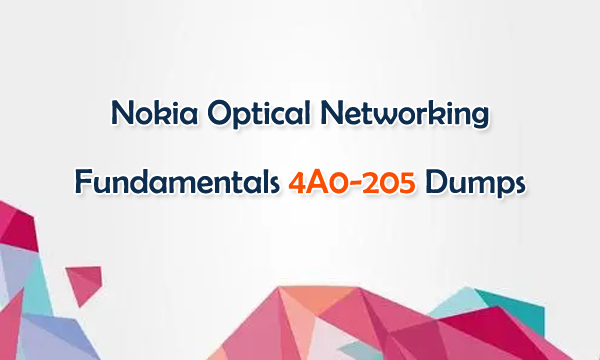Nokia Optical Networking Fundamentals 4A0-205 Dumps
February 17,2023 01:35 AM
Nokia Optical Networking Fundamentals 4A0-205 dumps questions are online, which are valuable in your preparation. Nokia certification 4A0-205 exam is a related test for Nokia Optical Network Professional Certification and Nokia Optical Network Services Expert Certification. To prepare for the Nokia 4A0-205 exam, Nokia recommends candidates to have a good understanding of the relevant technologies and experience in configuring and managing Nokia's SRA product portfolio.

Nokia 4A0-205 Exam Basic Information
Nokia Certification 4A0-205 exam basic information is available below.
Number of questions: 40
Language: English
Exam duration: 90 Minutes
Exam appointment duration: 110 minutes. This is the exam duration plus a 20-minute introductory survey.
Price: $125 US
4A0-205 Nokia Certification Exam Topics
Nokia Optical Networking Fundamentals 4A0-205 exam topics cover the following details.
Describe optical signal propagation in optical networks
Identify the typical building blocks of a WDM network
Describe the functionalities of the WDM building blocks
Identify the main engineering parameters that characterize the network equipment
Compute the power budget for an optical link
Describe the concept of trail and service
Identify the typical architectures for a WDM node
Classify the network levels and topologies
Get connected to 1830 PSS SWDM nodes using CLI, WebUI, and NFM-T
Recognize the main alarms, conditions, logs, and performance metrics
Perform channel power monitoring using Wavelength Tracker functionalities
Practice Nokia 4A0-205 Exam Dumps Questions
The new cracked Nokia Certification 4A0-205 exam dumps questions are the best guides for you to test the above Nokia Optical Networking Fundamentals topics. Share some Nokia 4A0-205 exam dumps questions and answers below.
1. Which of the following statements is true?
A. Alarms and conditions report only historical status of the node.
B. Alarms and conditions report a real time status of the node.
C. Logs report a real time status of the node.
D. Logs report both active and historical events.
Answer: D
2. A user needs to check for interface details against the commands is the correct one?
A. config interface detail 1/17/L1
B. show interface 11starla 1/17/L1 detail
C. config card 11star1a interface 1/17 detail
D. 11starla 1/17 port-detail
Answer: B
3. Which statement is correct about the NFM-T network map?
A. It allows the graphical visualization of the services deployed in the network with the details of the boards involved in the service.
B. It allows context sensitive navigation and represents nodes and related physical connections with different colors. depending on the active alarms.
C. It automatically represents all nodes grouped by the location string assigned during the NE creation.
D. It represents all supervised nodes grouped by alarm status (with a different color).
Answer: B
4. What is the purpose of the NFM-T node synchronization?
A. The partial or full node synchronization allows several entities/items defined at NFM-T level to be exported into an XML file, to be used as input for EPT (download to design).
B. The partial or full node synchronization allows several entities/items defined at node level to be retrieved into the NFM-T database (upload).
C. The partial or full node synchronization allows several entities/items defined at EPT level to be retrieved into the NFM-T database (upload from design).
D. The partial or full node synchronization allows several entities/items defined at NFM-T level to be written into the node database (download).
Answer: D
4A0-205 Exam Dumps PDF & SOFT | 1 Year Free Update | Money Back Guarantee
- Related Suggestion
- Nokia NSP IP Network Automation Professional Composite Exam 4A0-AI1 Dumps July 12,2023
- Nokia Service Routing Certification 4A0-113 Exam Dumps August 09,2021
- Nokia Bell Labs 5G Foundation BL0-100 Dumps Questions April 12,2021
- 4A0-M03 Nokia Mobility Manager Exam Dumps November 19,2020
- Nokia NRS II Certification Required Exams January 14,2020

